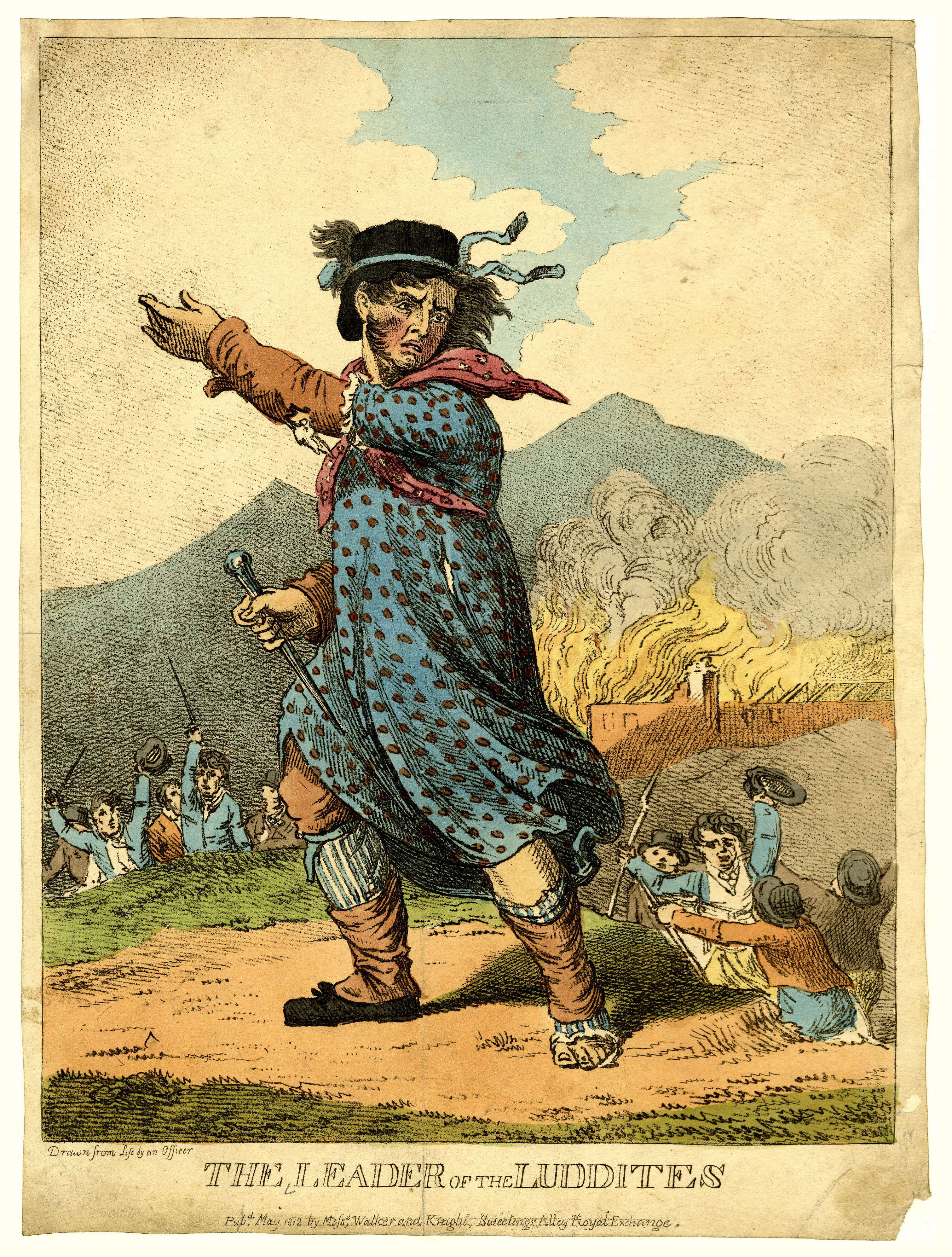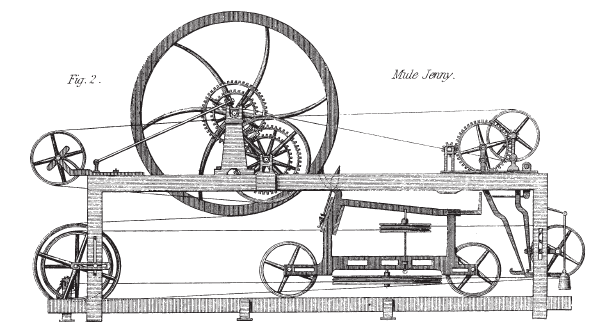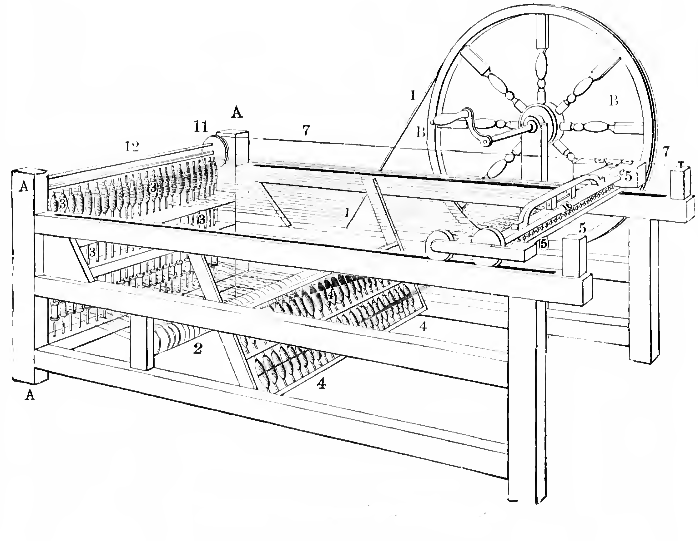|
Flying Shuttle
The flying shuttle was one of the key developments in the industrialization of weaving during the early Industrial Revolution. It allowed a single weaver to weave much wider fabrics, and it could be mechanized, allowing for automatic machine looms. The flying shuttle, which was patented by John Kay (1704– c. 1779) in 1733, greatly sped up the previous hand process and halved the labour force. Where a broad-cloth loom previously required a weaver on each side, it could now be worked by a single operator. Until this point, the textile industry had required four spinners to service one weaver. Kay's innovation, in wide use by the 1750s, greatly increased this disparity. History The device appears to have been invented in the region of Languedoc of southern France one year before its purported invention in England, but was destroyed by state cloth inspectors of the rent-seeking Ancien Regime. Operation In a typical frame loom, as used previous to the invention of the flying sh ... [...More Info...] [...Related Items...] OR: [Wikipedia] [Google] [Baidu] |
Shuttle With Bobin
The original meaning of the word shuttle is the device used in weaving to carry the weft. By reference to the continual to-and-fro motion associated with that, the term was then applied in transportation and then in other spheres. Thus the word may now also refer to: Transport Air transport * Air shuttle, a type of flight which quickly connects nearby destinations * Delta Shuttle, the brand name for Delta Air Lines' air shuttle service * Rossi Shuttle Quik, an Italian ultralight trike design * Shuttle America, a regional airline based in Indianapolis, Indiana * Shuttle by United, a regional airline operated as a subsidiary of United Airlines * Shuttle Carrier Aircraft, modified Boeing 747 airliners used to transport Space Shuttle orbiters * US Airways Shuttle, the brand name for an hourly service offered by US Airways * The call sign for domestic (UK internal) British Airways flights - international flights use Speedbird Land transport Automotive brands * Fit Shuttle, the ... [...More Info...] [...Related Items...] OR: [Wikipedia] [Google] [Baidu] |
Weft
Warp and weft are the two basic components used in weaving to turn thread or yarn into fabric. The lengthwise or longitudinal warp yarns are held stationary in tension on a frame or loom while the transverse weft (sometimes woof) is drawn through and inserted over and under the warp. A single thread of the weft crossing the warp is called a ''pick''. Terms vary (for instance, in North America, the weft is sometimes referred to as the ''fill'' or the ''filling yarn'').Barber (1991), p. 79 Each individual warp thread in a fabric is called a ''warp end'' or ''end''.Burnham (1980), pp. 170, 179 Inventions during the 18th century spurred the Industrial Revolution, with the "picking stick" and the " flying shuttle" ( John Kay, 1733) speeding up the production of cloth. The power loom patented by Edmund Cartwright in 1785 allowed sixty picks per minute. Etymology The word ''weft'' derives from the Old English word ''wefan'', to weave. ''Warp'' means "that which is thrown awa ... [...More Info...] [...Related Items...] OR: [Wikipedia] [Google] [Baidu] |
Rapier Loom
A rapier loom is a shuttleless weaving loom in which the filling yarn is carried through the shed of warp yarns to the other side of the loom by finger-like carriers called rapiers. A stationary package of yarn is used to supply the weft yarns in the rapier machine. One end of a rapier, a rod or steel tape, carries the weft yarn. The other end of the rapier is connected to the control system. The rapier moves across the width of the fabric, carrying the weft yarn across through the shed to the opposite side. The rapier is then retracted, leaving the new pick in place. In some versions of the loom, two rapiers are used, each half the width of the fabric in size. One rapier carries the yarn to the centre of the shed, where the opposing rapier picks up the yarn and carries it the remainder of the way across the shed. The double rapier is used more frequently than the single rapier due to its increased pick insertion speed and ability to weave wider widths of fabric. The housing f ... [...More Info...] [...Related Items...] OR: [Wikipedia] [Google] [Baidu] |
Her Majesty's Stationery Office
The Office of Public Sector Information (OPSI) is the body responsible for the operation of His Majesty's Stationery Office (HMSO) and of other public information services of the United Kingdom. The OPSI is part of the National Archives of the United Kingdom and is responsible for Crown copyright. The OPSI announced on 21 June 2006 that it was merging with the National Archives. The merger took place in October 2006. The OPSI continues to discharge its roles and responsibilities from within the structure of the National Archives. Controller of HMSO and Director of OPSI The Controller of HMSO is also the Director of OPSI. HMSO continues to operate from within the expanded remit of OPSI. The Controller of HMSO also holds the offices of Kings's Printer of Acts of Parliament, King's Printer for Scotland and Government Printer for Northern Ireland. By virtue of holding these offices OPSI publishes, through HMSO, the ''London Gazette'', ''Edinburgh Gazette'', ''Belfast Gazette'' a ... [...More Info...] [...Related Items...] OR: [Wikipedia] [Google] [Baidu] |
House Of Commons Of The United Kingdom
The House of Commons is the lower house of the Parliament of the United Kingdom. Like the upper house, the House of Lords, it meets in the Palace of Westminster in London, England. The House of Commons is an elected body consisting of 650 members known as Members of Parliament (UK), members of Parliament (MPs). MPs are elected to represent United Kingdom constituencies, constituencies by the first-past-the-post system and hold their seats until Dissolution of the Parliament of the United Kingdom, Parliament is dissolved. The House of Commons of England started to evolve in the 13th and 14th centuries. In 1707 it became the House of Commons of Great Britain after the Acts of Union 1707, political union with Scotland, and from 1800 it also became the House of Commons for Ireland after the Acts of Union 1800, political union of Great Britain and Ireland. In 1922, the body became the House of Commons of the United Kingdom of Great Britain and Northern Ireland after the independenc ... [...More Info...] [...Related Items...] OR: [Wikipedia] [Google] [Baidu] |
Industrial Accident
A work accident, workplace accident, occupational accident, or accident at work is a "discrete occurrence in the course of work" leading to physical or mental occupational injury. According to the International Labour Organization (ILO), more than 337 million accidents happen on the job each year, resulting, together with occupational diseases, in more than 2.3 million deaths annually. The phrase "in the course of work" can include work-related accidents happening off the company's premises, and can include accidents caused by third parties, according to Eurostat. The definition of work accident includes accidents occurring "while engaged in an economic activity, or at work, or carrying on the business of the employer" according to the ILO. The phrase "physical or mental harm" means any injury, disease, or death. Occupational accidents differ from occupational diseases as accidents are unexpected and unplanned occurrences (e.g., mine collapse), while occupational diseases are "co ... [...More Info...] [...Related Items...] OR: [Wikipedia] [Google] [Baidu] |
Luddite
The Luddites were a secret oath-based organisation of English textile workers in the 19th century who formed a radical faction which destroyed textile machinery. The group is believed to have taken its name from Ned Ludd, a legendary weaver supposedly from Anstey, near Leicester. They protested against manufacturers who used machines in what they called "a fraudulent and deceitful manner" to get around standard labour practices. Luddites feared that the time spent learning the skills of their craft would go to waste, as machines would replace their role in the industry. Many Luddites were owners of workshops that had closed because factories could sell the same products for less. But when workshop owners set out to find a job at a factory, it was very hard to find one because producing things in factories required fewer workers than producing those same things in a workshop. This left many people unemployed and angry. The Luddite movement began in Nottingham in England and ... [...More Info...] [...Related Items...] OR: [Wikipedia] [Google] [Baidu] |
United Kingdom
The United Kingdom of Great Britain and Northern Ireland, commonly known as the United Kingdom (UK) or Britain, is a country in Europe, off the north-western coast of the European mainland, continental mainland. It comprises England, Scotland, Wales and Northern Ireland. The United Kingdom includes the island of Great Britain, the north-eastern part of the island of Ireland, and many List of islands of the United Kingdom, smaller islands within the British Isles. Northern Ireland shares Republic of Ireland–United Kingdom border, a land border with the Republic of Ireland; otherwise, the United Kingdom is surrounded by the Atlantic Ocean, the North Sea, the English Channel, the Celtic Sea and the Irish Sea. The total area of the United Kingdom is , with an estimated 2020 population of more than 67 million people. The United Kingdom has evolved from a series of annexations, unions and separations of constituent countries over several hundred years. The Treaty of Union between ... [...More Info...] [...Related Items...] OR: [Wikipedia] [Google] [Baidu] |
Spinning Mule
The spinning mule is a machine used to spin cotton and other fibres. They were used extensively from the late 18th to the early 20th century in the mills of Lancashire and elsewhere. Mules were worked in pairs by a minder, with the help of two boys: the little piecer and the big or side piecer. The carriage carried up to 1,320 spindles and could be long, and would move forward and back a distance of four times a minute. It was invented between 1775 and 1779 by Samuel Crompton. The self-acting (automatic) mule was patented by Richard Roberts in 1825. At its peak there were 50,000,000 mule spindles in Lancashire alone. Modern versions are still in niche production and are used to spin woollen yarns from noble fibres such as cashmere, ultra-fine merino and alpaca for the knitware market. The spinning mule spins textile fibres into yarn by an intermittent process. In the draw stroke, the roving is pulled through rollers and twisted; on the return it is wrapped onto the spin ... [...More Info...] [...Related Items...] OR: [Wikipedia] [Google] [Baidu] |
Waterframe
The water frame is a spinning frame that is powered by a water-wheel. Water frames in general have existed since Ancient Egypt times. Richard Arkwright, who patented the technology in 1769, designed a model for the production of cotton thread; this was first used in 1765. The Arkwright water frame was able to spin 96 threads at a time, which was an easier and faster method than ever before. The design was partly based on a spinning machine built for Thomas Highs by clockmaker John Kay, who was hired by Arkwright. Being run on water power, it produced stronger and harder yarn than the then-famous "spinning jenny", and propelled the adoption of the modern factory system. Another water-powered frame for the production of textiles was developed in 1760, in the early industrialized town of Elberfeld, Prussia (now in Wuppertal, Germany), by German bleach plant owner Johann Heinrich Bockmühl. The name ''water frame'' is derived from the use of a water wheel to drive a number of spi ... [...More Info...] [...Related Items...] OR: [Wikipedia] [Google] [Baidu] |
Spinning Jenny
The spinning jenny is a multi- spindle spinning frame, and was one of the key developments in the industrialization of textile manufacturing during the early Industrial Revolution. It was invented in 1764 or 1765 by James Hargreaves in Stanhill, Oswaldtwistle, Lancashire in England. The device reduced the amount of work needed to produce cloth, with a worker able to work eight or more spools at once. This grew to 120 as technology advanced. The yarn produced by the jenny was not very strong until Richard Arkwright invented the water-powered water frame. The spinning jenny helped to start the factory system of cotton manufacturing. History The spinning jenny was invented by James Hargreaves. He was born in Oswaldtwistle, near Blackburn, around 1720. Blackburn was a town with a population of about 5,000, known for the production of "Blackburn greys," cloths of linen warp and cotton weft initially imported from India. They were usually sent to London to be printed. ... [...More Info...] [...Related Items...] OR: [Wikipedia] [Google] [Baidu] |
Pirn
A Pirn is a rod onto which weft thread is wound for use in weaving. Unlike a bobbin A bobbin or spool is a spindle or cylinder, with or without flanges, on which yarn, thread, wire, tape or film is wound. Bobbins are typically found in industrial textile machinery, as well as in sewing machines, fishing reels, tape measu ..., it is fixed in place, and the thread is delivered off the end of the pirn rather than from the centre. A typical pirn is made of wood or plastic and is slightly tapered for most of its length, flaring out more sharply at the base, which fits over a pin in the shuttle. Pirns are wound from the base forward in order to ensure snag-free delivery of the thread, unlike bobbins, which are wound evenly from end to end. Pirns became important with the development of the flying shuttle, though they are also used with other end delivery shuttles. Power looms which use pirns generally have automatic changing mechanisms which remove the spent pirn from the ... [...More Info...] [...Related Items...] OR: [Wikipedia] [Google] [Baidu] |


.jpg)



